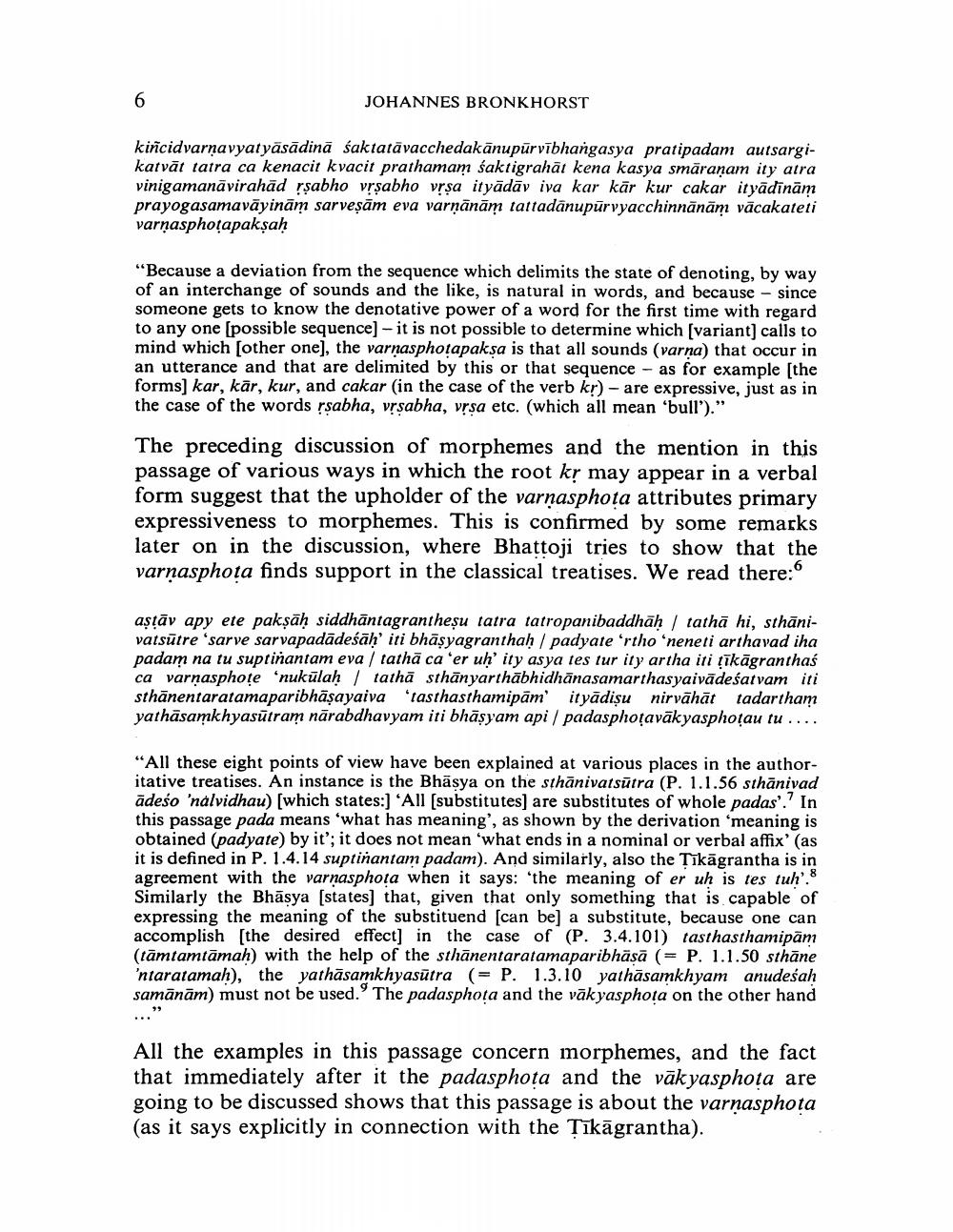________________
JOHANNES BRONKHORST
kiñcidvarnavyat yāsādināśaktatāvacchedakānupūrvībhangasya pratipadam autsargikatvāt tatra ca kenacit kvacit prathamam śaktigrahāt kena kasya smāranam ity atra vinigamanāvirahād rşabho vrṣabho vrsa ityādāv iva kar kār kur cakar ityādinām prayogasamavāyinām sarveșām eva varṇānām tattadānupūrvyacchinnānām vācakateti varnasphotapakşah
"Because a deviation from the sequence which delimits the state of denoting, by way of an interchange of sounds and the like, is natural in words, and because - since someone gets to know the denotative power of a word for the first time with regard to any one (possible sequence] - it is not possible to determine which (variant) calls to mind which [other one), the varnasphotapaksa is that all sounds (varna) that occur in an utterance and that are delimited by this or that sequence - as for example (the forms) kar, kār, kur, and cakar (in the case of the verb kr) - are expressive, just as in the case of the words rsabha, vrsabha, vrsa etc. (which all mean 'bull')."
The preceding discussion of morphemes and the mention in this passage of various ways in which the root kr may appear in a verbal form suggest that the upholder of the varnasphota attributes primary expressiveness to morphemes. This is confirmed by some remarks later on in the discussion, where Bhattoji tries to show that the varnasphota finds support in the classical treatises. We read there:
astāv apy ete pakṣāḥ siddhāntagrantheșu tatra tatropanibaddhāḥ / tathā hi, sthānivatsūtre 'sarve sarvapadādeśāḥ' iti bhāşyagranthah / padyate ‘rtho 'neneti arthavad iha padam na tu suptiñantam eva / tathā ca er uh' ity asya tes tur ity artha iti tīkāgranthas ca varnasphote 'nukülah / tathā sthānyarthābhidhānasamarthasyaivādeśatvam iti sthānentaratamaparibhāşayaiva 'tasthasthamipām'ityādişu nirvāhāt tadartham yathāsamkhyasūtram nārabdhavyam iti bhāṣyam api / padasphoțavāk yasphoțau tu ....
“All these eight points of view have been explained at various places in the authoritative treatises. An instance is the Bhāsya on the sthānivatsūtra (P. 1.1.56 sthānivad ādeso 'nalvidhau) (which states:] 'All (substitutes] are substitutes of whole padas'. In this passage pada means 'what has meaning', as shown by the derivation meaning is obtained (padyate) by it'; it does not mean 'what ends in a nominal or verbal affix' (as it is defined in P. 1.4.14 suptiñantam padam). And similarly, also the Tīkāgrantha is in agreement with the varnasphota when it says: 'the meaning of er uh is tes tuh'.8 Similarly the Bhāsya [states) that, given that only something that is capable of expressing the meaning of the substituend (can be] a substitute, because one can accomplish (the desired effect] in the case of (P. 3.4.101) tasthasthamipām (tāmtamtāmah) with the help of the sthānentaratamaparibhāsā (= P. 1.1.50 sthāne 'ntaratamah), the pathāsamkhyasūtra (= P. 1.3.10 yathāsamkhyam anudeśah samānām) must not be used. The padasphota and the vāk yasphota on the other hand
All the examples in this passage concern morphemes, and the fact that immediately after it the padasphota and the vāk yasphota are going to be discussed shows that this passage is about the varnasphota (as it says explicitly in connection with the Tīkāgrantha).




